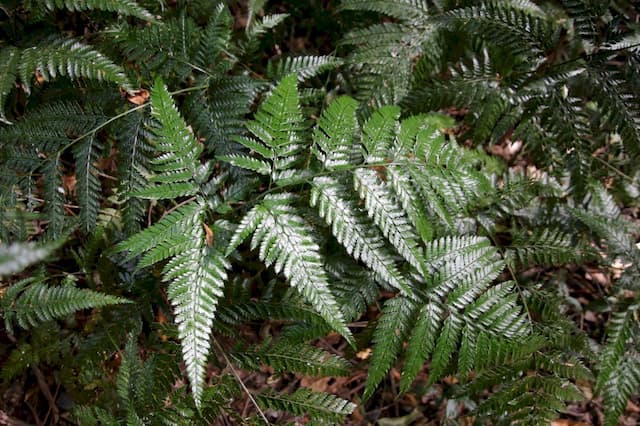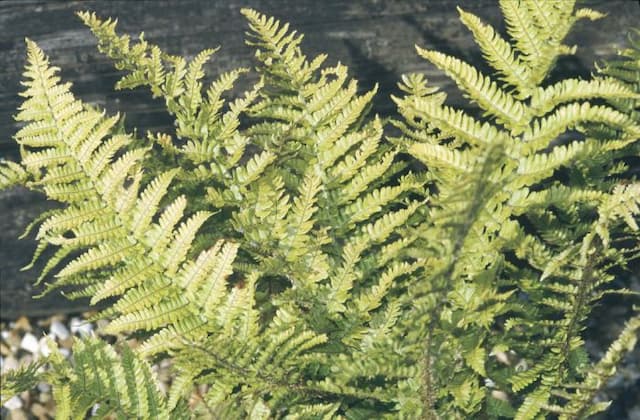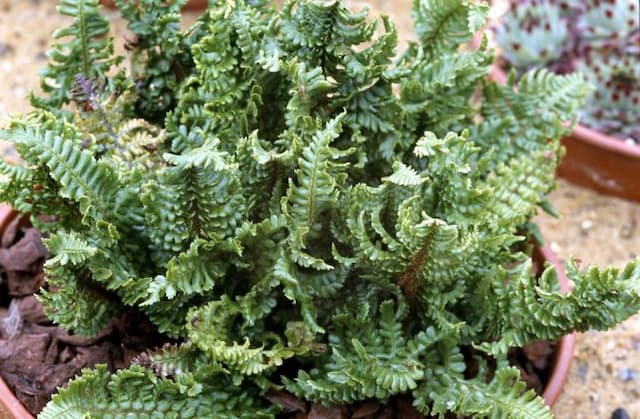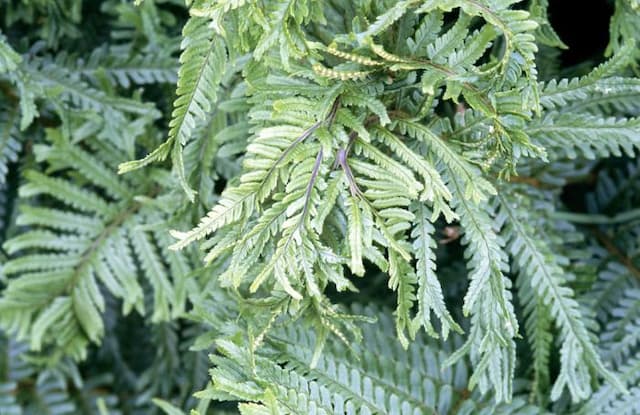Soft shield fern Polystichum setiferum 'Pulcherrimum Bevis'











ABOUT
The Polystichum setiferum 'Pulcherrimum Bevis', commonly known as the soft shield fern, is a perennial fern with a delicate and lacy appearance. It boasts a symmetrical and arching foliage structure, with fronds that unfurl from a central rosette. The leaves are finely divided, giving them a soft texture to the touch. They possess a fresh, deep green color that can provide a lush, verdant look in garden settings. Each leaf on the soft shield fern is intricately structured with numerous small leaflets, which are arranged in a feathery pattern along the fronds' axes. The leaflets themselves may be somewhat crinkled or wrinkled, adding to the fern's ornamental appeal. The stalks that support the fronds are typically a contrasting color, often displaying a pale or golden brown hue, which further accentuates the vibrant green of the leaves. During the growing season, the soft shield fern remains evergreen, making it a valuable plant for year-round interest in the garden. In the right conditions, its delicate fronds can create a graceful and airy texture, making it a popular choice for shaded or woodland garden areas. The plant exudes an elegant and timeless charm, often used in understory plantings or as a background foliage to complement flowering plants.
About this plant
 Names
NamesFamily
Dryopteridaceae
Synonyms
Soft Shield Fern, Bevis Soft Shield Fern
Common names
Polystichum setiferum 'Pulcherrimum Bevis'.
 Toxicity
ToxicityTo humans
The Soft Shield Fern (Polystichum setiferum 'Pulcherrimum Bevis') is generally considered non-toxic to humans. There are no widely recognized symptoms of poisoning because it is not known to be poisonous if ingested. Consequently, accidental ingestion of the Soft Shield Fern should not result in any serious consequences.
To pets
The Soft Shield Fern (Polystichum setiferum 'Pulcherrimum Bevis') is also generally considered non-toxic to pets. Like with humans, there is no evidence to suggest that ingestion of this plant causes poisoning in animals. Therefore, the consumption of any part of the Soft Shield Fern should not lead to any significant health issues in pets.
 Characteristics
CharacteristicsLife cycle
Perennials
Foliage type
Evergreen
Color of leaves
Green
Height
2-3 feet (60-90 cm)
Spread
2-3 feet (60-90 cm)
Plant type
Fern
Hardiness zones
8-9
Native area
Europe
Benefits
 General Benefits
General Benefits- Aesthetic Appeal: Adds visual interest with its delicate, fine-textured fronds.
- Landscape Versatility: Suitable for shaded borders and woodland garden designs.
- Low Maintenance: Requires minimal care once established, less frequent watering and fertilizing.
- Drought Tolerance: Can survive in drier conditions once fully grown.
- Evergreen Foliage: Provides year-round greenery in the garden.
- Wildlife Support: Offers habitat to insects and birds in the garden ecosystem.
- Erosion Control: Root system helps stabilize soil in sloped or shaded areas.
- Winter Interest: Retains its foliage in winter, adding greenery to barren landscapes.
- Companion Planting: Complements flowering plants and provides textural contrast.
 Medical Properties
Medical PropertiesThis plant is not used for medical purposes.
 Air-purifying Qualities
Air-purifying QualitiesThis plant is not specifically known for air purifying qualities.
 Other Uses
Other Uses- Soft Landscaping Filler: Due to its dense and feathery foliage, Polystichum setiferum 'Pulcherrimum Bevis', or Soft Shield Fern, works well as a filler in soft landscaping designs to create lush, textured underplanting in woodland or shaded garden areas.
- Artistic Impressions: The delicate fronds of Soft Shield Fern can be used to make botanical prints or to add an intricate touch to art pieces, including eco-printing on fabrics or paper.
- Biodegradable Mulch: When the fronds of the Soft Shield Fern die back or are pruned, they can be laid around other plants as a natural, biodegradable mulch that eventually decomposes and enriches the soil.
- Garden Sculptures: Live or dried fronds from the fern can be incorporated into garden sculptures or topiaries, providing a unique texture and color contrast.
- Education and Study: Soft Shield Fern can be used in educational settings for plant identification and horticultural training due to its distinct morphology among ferns.
- Thematic Gardens: This fern is perfect for creating a 'fernery' or a shade garden theme that focuses on various shades and textures of greenery.
- Dry Shade Gardening: Soft Shield Fern thrives in difficult dry shade locations where other plants might struggle, offering an option for challenging gardening spots.
- Container Gardening: The fern can be grown in containers to create varied levels and textures in balcony gardens or patios with limited space.
- Water Features: Soft Shield Fern can be planted around the edges of ponds or streams to create a more naturalized and serene water feature setting.
- Backdrop for Spring Bulbs: The foliage of the Soft Shield Fern provides an excellent backdrop for flowering spring bulbs, highlighting their colors and making them stand out in a garden display.
Interesting Facts
 Feng Shui
Feng ShuiThe Soft Shield Fern is not used in Feng Shui practice.
 Zodiac Sign Compitability
Zodiac Sign CompitabilityThe Soft Shield Fern is not used in astrology practice.
 Plant Symbolism
Plant Symbolism- Endurance: The plant's evergreen nature symbolizes the ability to endure and persist through various conditions and over long periods.
- Protection: Polystichum setiferum, commonly known as Soft Shield Fern, has fronds that unfold in a protective manner, which can symbolize shelter and refuge.
- Rebirth: Ferns in general are often associated with new beginnings and rejuvenation, as they are among the first plants to grow back in the wild after a disturbance.
- Solitude: Soft Shield Fern's preference for shady, secluded areas can represent a need for privacy or time for self-reflection.
 Water
WaterThe Soft Shield Fern, commonly known as Polystichum setiferum 'Pulcherrimum Bevis', prefers to be watered thoroughly, ensuring that the soil is evenly moist but not waterlogged. During the growing season in spring and summer, water the plant once or twice a week, depending on the climate and indoor conditions. Each watering should provide enough water to soak the root zone, which can be roughly equivalent to 1 to 2 gallons for a medium-sized fern in an indoor setting. Cut back on watering during the cooler, dormant months to once every two weeks or when the top inch of soil feels dry. Avoid overhead watering to minimize the risk of fungal diseases.
 Light
LightFor the Soft Shield Fern, the ideal light conditions are indirect, dappled light or part shade. It should be placed in a location where it's shielded from direct afternoon sunlight, which can scorch its delicate fronds. A north-facing window or a spot that receives filtered light through sheer curtains is ideal. If grown outdoors, it thrives under the canopy of taller trees or on the north side of buildings.
 Temperature
TemperatureThe Soft Shield Fern thrives in temperatures between 60°F and 75°F, which are typical for indoor environments. It is hardy and can tolerate temperatures down to around 50°F and up to about 80°F. Avoid exposing the fern to temperatures below 50°F as it may result in cold damage, and sustained high temperatures over 80°F can stress the plant.
 Pruning
PruningPruning the Soft Shield Fern is primarily done to remove dead or damaged fronds, which can be cut back at the base as needed to maintain its aesthetic appearance. The best time to prune is in the spring, just before new growth begins, but spot-cleaning of the fern can occur year-round. Regularly removing older fronds can also improve air circulation, which is beneficial for the plant's health.
 Cleaning
CleaningAs needed
 Soil
SoilSoft shield fern requires well-drained, moist soil rich in organic matter. A mixture of two parts garden loam, one part peat moss or leaf mold, and one part sharp sand or perlite is ideal. The pH should be slightly acidic to neutral, ranging between 5.5 and 7.
 Repotting
RepottingSoft shield ferns do not require frequent repotting; they can be repotted every 2 to 3 years or when they outgrow their containers. It's best done in spring or early summer.
 Humidity & Misting
Humidity & MistingSoft shield fern thrives in high humidity levels, preferably between 60% and 70%. It's beneficial to maintain consistent humidity without fluctuations to emulate its natural woodland habitat.
 Suitable locations
Suitable locationsIndoor
Keep in medium light, ensure high humidity, and water regularly.
Outdoor
Plant in shady spot with moist, rich soil; protect from wind.
Hardiness zone
5-9 USDA
 Life cycle
Life cycleThe Polystichum setiferum 'Pulcherrimum Bevis', commonly known as Soft Shield Fern, begins its life cycle as a spore, which under suitable moist and shaded conditions germinates to produce a small, heart-shaped gametophyte. This haploid gametophyte, through the process of fertilization, gives rise to a young fern (sporophyte), which gradually matures into an identifiable Soft Shield Fern. Once mature, the fern produces distinctive fronds that uncurl from a central rhizome, displaying the characteristic soft, feathery texture. As the plant ages, it forms a clump of arching fronds that can reach up to 60-90 cm (24-35 inches) in length. On the underside of these mature fronds, sori containing spores develop; when these spores mature, they are dispersed by wind to begin a new cycle. Throughout its life, the fern will continue to grow larger, producing more fronds every year if conditions are favorable, following a perennial growth pattern.
 Propogation
PropogationPropogation time
Spring to Summer
The Soft Shield Fern (Polystichum setiferum 'Pulcherrimum Bevis') is typically propagated by division. This is done by gently separating the fern's rhizomes, which are the horizontal underground stems from which the fronds emerge. The best time to propagate by division is in the spring, as the plant comes out of dormancy and the new growth begins to appear. When dividing the fern, each section should have at least one growing tip and several healthy fronds attached. The sections can then be planted directly into the soil, placed at the same depth they were growing at previously, and kept moist until they establish a new root system. With proper care, these divisions can grow into full-sized plants over the course of the growing season.









